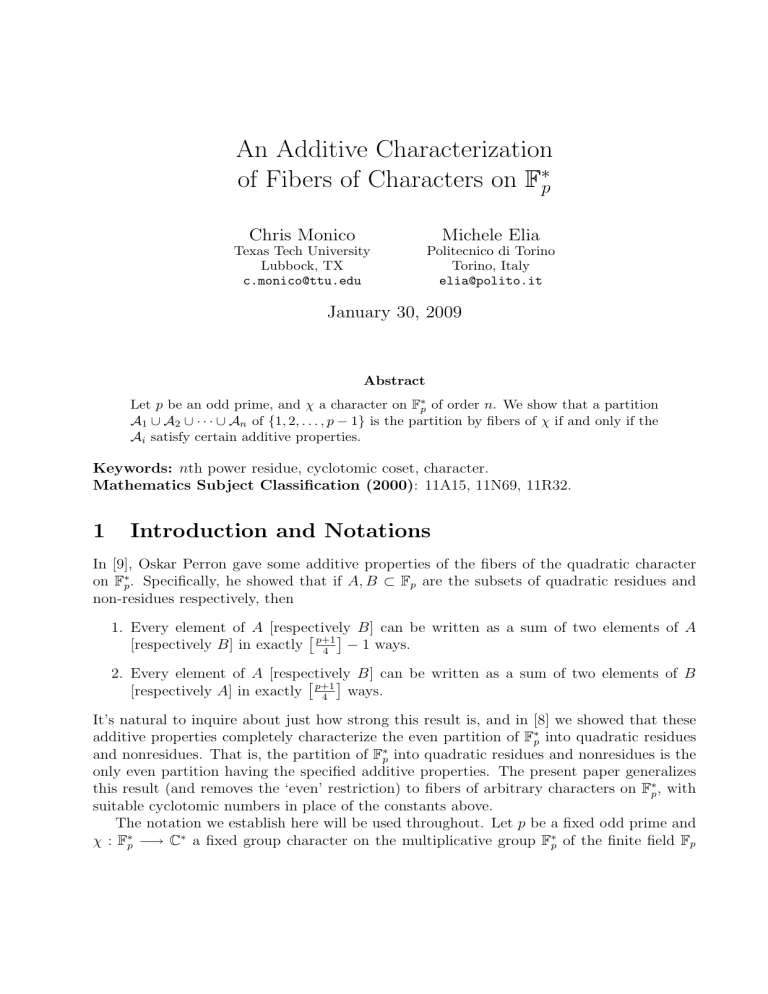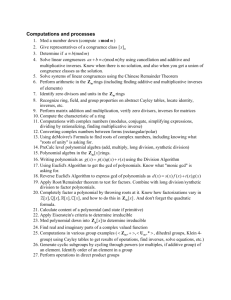An Additive Characterization of Fibers of Characters on F ∗ p
advertisement

An Additive Characterization
of Fibers of Characters on F∗p
Chris Monico
Michele Elia
Texas Tech University
Lubbock, TX
c.monico@ttu.edu
Politecnico di Torino
Torino, Italy
elia@polito.it
January 30, 2009
Abstract
Let p be an odd prime, and χ a character on F∗p of order n. We show that a partition
A1 ∪ A2 ∪ · · · ∪ An of {1, 2, . . . , p − 1} is the partition by fibers of χ if and only if the
Ai satisfy certain additive properties.
Keywords: nth power residue, cyclotomic coset, character.
Mathematics Subject Classification (2000): 11A15, 11N69, 11R32.
1
Introduction and Notations
In [9], Oskar Perron gave some additive properties of the fibers of the quadratic character
on F∗p . Specifically, he showed that if A, B ⊂ Fp are the subsets of quadratic residues and
non-residues respectively, then
1. Every element of A [respectively
p+1 B] can be written as a sum of two elements of A
[respectively B] in exactly 4 − 1 ways.
2. Every element of A [respectively
p+1 B] can be written as a sum of two elements of B
[respectively A] in exactly 4 ways.
It’s natural to inquire about just how strong this result is, and in [8] we showed that these
additive properties completely characterize the even partition of F∗p into quadratic residues
and nonresidues. That is, the partition of F∗p into quadratic residues and nonresidues is the
only even partition having the specified additive properties. The present paper generalizes
this result (and removes the ‘even’ restriction) to fibers of arbitrary characters on F∗p , with
suitable cyclotomic numbers in place of the constants above.
The notation we establish here will be used throughout. Let p be a fixed odd prime and
χ : F∗p −→ C∗ a fixed group character on the multiplicative group F∗p of the finite field Fp
of order p. Then for some n dividing p − 1 and some generator g of F∗p , the character χ
is induced by χ(g) = e2πi/n . For each integer k let Ak be the fiber χ−1 ({e2kπi/n }). Then
the fiber An is the set of n-th power residues modulo p and the fibers A1 , . . . , An form a
partition of {1, 2 . . . , p−1} with |Ak | = p−1
= s for each k. The sets Ak are sometimes called
n
cyclotomic classes or cyclotomic cosets. For each k ∈ Z we define a polynomial rk (x) ∈ Z[x]
by
X
rk (x) =
xj .
j∈Ak
Note that ηk = rk (exp(2πi/p)) is an s-nomial period [3].
Since the fibers A1 , . . . , An form a partition of F∗p we have
1+
X
X
rk (x) =
0≤j<p
1≤k≤n
xj =
xp − 1
,
x−1
(1.1)
as well as the following proposition.
Proposition 1.1 The set {1} ∪ {rk (x) : 1 ≤ k ≤ n} is a basis of a Q-subspace Vn+1 of
dimension n + 1 in the p-dimensional vector space Q[x]/hxp − 1i of polynomials of degree at
most p − 1.
2
Main Theorem
Our immediate goal is to show that Vn+1 is actually a Q-subalgebra of Q[x]/hxp − 1i. First a
lemma is required. Let Q(ζp ) be the cyclotomic field of p-th roots of unity, with ζp denoting
a primitive root of unity. The Galois group G = G(Q(ζp )|Q) of Q(ζp ) over Q is isomorphic
to F∗p via a 7→ σa where
σa (ζp ) = ζpa , a ∈ F∗p .
Since g is a generator of F∗p we have G = hσg i. Let Gn and Gs be the subgroups of G having
order n and s respectively, so that Gn = hσgs i and Gs = hσgn i.
We define the period polynomial [3] Pn (y) by
Pn (y) =
n
Y
(y − rk (ζp )) .
k=1
A priori, Pn (y) ∈ Q(ζp )[y], but the following lemma shows that the coefficients are actually
integers.
Lemma 2.1 Let Pn (y) be as above. Then
1. Pn (y) ∈ Z[y],
2. If E = Q(r1 (ζp ), . . . , rn (ζp )) ⊃ Q is the splitting field of Pn then [E : Q] = n. In
particular, E = Q[r1 (ζp ), . . . , rn (ζp )].
2
Proof: Notice that with G = hσg i as above, we have
X
X
σg (rk (ζp )) = rk (ζpg ) =
ζpgj =
ζpj = rk+1 (ζp ),
j∈Ak
j∈gAk
with the last equality following from gAk = Ak+1 . Since rn+1 (ζp ) = r1 (ζp ), σg permutes of
the roots of Pn . In particular, the coefficients of Pn are invariant under the action of the
entire Galois group G, and so they are in Q since Q(ζp ) is Galois over Q. Furthermore, since
the rk (ζp ) are algebraic integers, so are the coefficients of Pn , and hence Pn ∈ Z[y].
For the second part, notice that for every 1 ≤ k ≤ n we have
n
σgn (rk (ζp )) = rk (ζpg ) = rk+n (ζp ) = rk (ζp ).
Since Gs = hσgn i, it follows that E is fixed by Gs and so Gs ⊆ G(Q(ζp )|E). By the Fundamental Theorem of Galois Theory [4], we then have
[Q(ζp ) : E] = |G(Q(ζp )|E)| ≥ s,
and
[E : Q] =
[Q(ζp ) : Q]
ns
=
≤ n.
[Q(ζp ) : E]
[Q(ζp ) : E]
On the other hand, r1 (ζp ), . . . , rn (ζp ) are n linearly independent elements of E so that [E :
Q] ≥ n.
The first half of our main theorem is encapsulated by the following lemma, which is
closely related to Lemma 10.10.2 of [3].
Lemma 2.2 The Q-vector space Vn+1 of Proposition 1.1 is a Q-subalgebra of Q[x]/hxp − 1i.
In particular, for every 1 ≤ i, j ≤ n there exist integers cijk such that
ri (x)rj (x) ≡ cij0 +
n
X
cijk rk (x)
(mod hxp − 1i) .
k=1
Proof: Let i, j ∈ {1, 2, . . . , n} and let Φp (x) = (xp − 1)/(x − 1) be the p-th cyclotomic
polynomial. It follows from Lemma 2.1 that there are constants e
cijk and a polynomial
hij (x) ∈ Q[x] so that
n
X
ri (x)rj (x) =
e
cijk rk (x) + hij (x)Φp (x).
k=1
Since Φp (x) = 1 +
Pn
k=1 rk (x),
ri (x)rj (x) =
n
X
we have
e
cijk rk (x) + hij (1) 1 +
k=1
!
rk (x)
+ (hij (x) − hij (1))Φp (x)
k=1
≡ hij (1) +
≡ cij0 +
n
X
n
X
k=1
n
X
(hij (1) + e
cijk )rk (x)
cijk rk (x)
(mod hxp − 1i)
(mod hxp − 1i) ,
k=1
3
where cij0 = hij (1) and cijk = hij (1) + e
cijk for 1 ≤ k ≤ n. It follows that the cijk are integers
since the coefficients of ri , rj , and xp − 1 are all integers.
Remark 2.3 Evaluating the equation stated in Lemma 2.2 at x = exp(2πi/p) and recalling
that ηk = rk (exp(2πi/p)) we obtain
ηi ηj = cij0 +
n
X
cijk ηk .
k=1
Since the ηi are Q-linearly independent, comparison with Lemma 10.10.2 of [3] shows that
cijk = (j − i, k − i)n , where (a, b)n denotes a cyclotomic number of order n.
Corollary 2.4 For 1 ≤ i, j, k ≤ n, each element of Ak can be written as the sum of an
element of Ai and an element of Aj in precisely cijk ways, where cijk are the constants given
by Lemma 2.2.
The goal is to show that the additive property described by Corollary 2.4 completely
characterizes the partition F∗p = A1 ∪ · · · ∪ An . That is to say, this is the only partition of
Fp∗ into n sets satisfying the conclusion of the corollary.
Theorem 2.5 For 1 ≤ i, j, k ≤ n, let cijk be the constants in Lemma 2.2. Suppose
A01 , . . . , A0n is a partition of F∗p with the property that each element of A0k can be written
as the sum of an element from A0i and an element from A0j in exactly cijk ways. Then for
some permutation τ of {1, 2, . . . , n}, we have A0i = Aτ (i) .
P
Proof: Let ri (x) be as above and set ri0 (x) = j∈A0 xj . The hypotheses imply that ri0 (x)rj0 (x) ≡
j
P
cij0 + nk=1 cijk rk0 (x) (mod hxp − 1i) and in particular,
ri0 (ζp )rj0 (ζp )
= cij0 +
n
X
cijk rk0 (ζp ).
(2.2)
k=1
Consider the map
ψ : Q[r10 (ζp ), . . . , rn0 (ζp )] −→ Q[r1 (ζp ), . . . , rn (ζp )] = E
rj0 (ζp ) 7−→ rj (ζp ).
Since r10 (ζp ), . . . , rn0 (ζp ) are Q-linearly independent, ψ is a vector space isomorphism. Then
(2.2) implies that ψ is actually a Q-algebra isomorphism. Therefore, Q[r10 (ζp ), . . . , rn0 (ζp )] is
a field of degree n over Q. But since the Galois group G(Q(ζp )|Q) is cyclic, there is only one
such subfield of Q(ζp ), namely E. So there are constants mij ∈ Q for which
ri0 (ζp ) =
n
X
j=1
4
mij rj (ζp ).
By writing the ri0 (ζp ), rj (ζp ) in terms of the basis {ζp , ζp2 , . . . , ζpp−1 } of Q(ζp ), we see that
mij ∈ {0, 1} since the coefficients of ri0 (x), rj (x) are in {0, 1} and the terms of each ri0 (x) [and
ri (x)] are distinct. Now with K = Q(ζp ) we have
!
n
n
X
X
−ns = Tr K|Q
ri0 (ζp )
=
Tr K|Q (ri0 (ζp ))
i=1
i=1
=
n X
n
X
mij Tr K|Q (rj (ζp ))
i=1 j=1
n X
n
X
= −s
mij .
i=1 j=1
P P
Therefore, ni=1 nj=1 mij = n. But since M = (mij ) is invertible n × n and the entries are
in {0, 1}, it follows that M must have exactly one 1 in each row and one 1 in each column.
So there is a permutation τ of {1, 2, . . . , n} with ri0 (ζp ) = rτ (i) (ζp ) for all 1 ≤ i ≤ n.
Fix i ∈ {1, 2, . . . , n} and let hi (x) ∈ Z[x] so that ri0 (x) = rτ (i) (x) + hi (x)Φp (x). Evaluation
at x = 1 shows that ri0 (1) = s + hi (1) · p, and hence ri0 (1) ≡ s (mod p) . By construction,
0 < ri0 (1) ≤ p, so we must have ri0 (1) = s. Then ri0 (x) − rτ (i) (x) ∈ hΦp (x)i ∩ hx − 1i = hxp − 1i.
But since ri0 (x), rτ (i) (x) each have degree at most p − 1, it follows that ri0 (x) = rτ (i) (x) and
hence Ai = Aτ (i) .
Notice that given p and the polynomial Pn , the fibers of χ may be recovered by expressing
the roots of Pn in terms of the basis {ζp , ζp2 , . . . , ζpp−1 } of Q(ζp ). So the polynomial Pn encodes
the fibers of χ in some sense. From [8], it follows that if χ is the quadratic character on Fp ,
then
2
y + y − p+1
,
if p ≡ 1 (mod 4) ,
4 P2 (y) =
p+1
2
y +y+ 4 ,
if p ≡ 3 (mod 4) ,
where [−] is the greatest integer function. For arbitrary characters we do not have such an
explicit result, but the following proposition gives some information.
Proposition 2.6 Let p, n and Pn be as above. Then
Pn (y) ≡ (y + 1/n)n (mod p) .
Proof: Consider the ring homomorphism ψ : Z[ζp ] −→ Fp determined by ψ(ζp ) = 1. This
naturally extends to a homomorphism ψ : Z[ζp ][y] −→ Fp [y] with ψ(y) = y and
!
n
n
n Y
Y
Y
p−1
≡ (y + 1/n)n (mod p) .
ψ(f (y)) = ψ
(y − rk (ζp )) ≡
(y − rk (1)) ≡
y−
n
k=1
k=1
k=1
On the other hand, the coefficients of Pn are actually in Z so that Pn (y) ≡ (y+1/n)n (mod p) .
5
3
Examples
It’s not difficult to see that the polynomial Pn (y) depends only on p and n and not on the
particular character χ (of course, n depends on χ since n is the cardinality of the image of
χ). The polynomials corresponding to n = 4 for the first several primes p ≡ 1 (mod 4) are
given in the following table.
p
5
13
17
29
37
41
53
61
f (y)
y4 + y3 + y2 + y + 1
y 4 + y 3 + 2y 2 − 4y + 3
y 4 + y 3 − 6y 2 − y + 1
y 4 + y 3 + 4y 2 + 20y + 23
y 4 + y 3 + 5y 2 + 7y + 49
y 4 + y 3 − 15y 2 + 18y − 4
y 4 + y 3 + 7y 2 − 43y + 47
y 4 + y 3 + 8y 2 + 42y + 117
In [8] the complete additive characterization of the quadratic residues based on two polynomials r1 (x) and r2 (x) was given. The three polynomials 1, r1 (x), r2 (x) define a polynomial
algebra of dimension 3 in the polynomial ring Q[x] modulo hxp −1i. These three polynomials
are solutions to
p+1
p+1
2
Z + Z − (−1|p)
+
Φp (x) ≡ 0
(mod hxp − 1i) .
4
4
Furthermore, the multiplication constants for this algebra were explicitly determined in that
paper. Multiplication by 1 is trivial, and with dp = [(p + 1)/4], the products of the other
basis polynomials are
r1 (x)2 ≡ (1 + (−1|p)) p−1
r (x) + (dp − 1)r1 (x) + dp r2 (x)
(mod hxp − 1i)
4 0
p−1
2
r2 (x) ≡ (1 + (−1|p)) 4 r0 (x) + dp r1 (x) + (dp − 1)r2 (x)
(mod hxp − 1i)
r0 (x) + [p/4]r1 (x) + [p/4]r2 (x)
(mod hxp − 1i)
r1 (x)r2 (x) ≡ (1 − (−1|p)) p−1
4
Here, the uniqueness of polynomials r1 (x) and r2 (x) satisfying the above equations follows
from properties of the Galois group of the cyclotomic field Q(ζp ) with ζp a p-th root of unity.
The general result will now be illustrated with two further numerical examples for 3-power
and 4-power residues obtained considering p = 13.
A primitive root in F∗13 is g = 2, and for the 3-power residues we consider the character
determined by χ(2) = e2πi/3 . The fibers of this character are A1 = {2, 3, 10, 11}, A2 =
{4, 6, 7, 9}, and A3 = {1, 5, 8, 12}. The associated polynomials are
r1 (x) = x2 + x3 + x10 + x11 ,
r2 (x) = x4 + x6 + x7 + x9 ,
r3 (x) = x + x5 + x8 + x12 .
Together with the polynomial 1, these are precisely the solutions of the equation
Z 3 + Z 2 − 4Z + 1 − 5Φ13 (x) = 0 (mod hx13 − 1i) .
6
The vector space V4 ⊂ Q[x]/hx13 − 1i has basis {1, r1 , r2 , r3 }. Associating an element α0 +
α1 r1 + α2 r2 + α3 r3 with the vector (α0 , α1 , α2 , α3 ), the multiplication on V4 is given by the
following.
(1, 0, 0, 0)
(0, 1, 0, 0)
(0, 0, 1, 0)
(0, 0, 0, 1)
(1, 0, 0, 0)
(1, 0, 0, 0)
(0, 1, 0, 0)
(0, 0, 1, 0)
(0, 0, 0, 1)
(0, 1, 0, 0)
(0, 1, 0, 0)
(4, 0, 1, 2)
(0, 1, 2, 1)
(0, 2, 1, 1)
(0, 0, 1, 0)
(0, 0, 1, 0)
(0, 1, 2, 1)
(4, 2, 0, 1)
(0, 1, 1, 2)
(0, 0, 0, 1)
(0, 0, 0, 1)
(0, 2, 1, 1)
(0, 1, 1, 2)
(4, 1, 2, 0)
From this, one may immediately read off the cijk constants from Lemma 2.2; for example,
c230 = 0, c231 = 1, c232 = 1, c233 = 2. From c231 = 1 we conclude that each element of A1
can be written as the sum of an element of A2 and an element of A3 in exactly one way.
Note also that in each column we may read the matrices, of a matrix representation of the
polynomial algebra V4 . The cubic polynomial f (Z) = Z 3 + Z 2 − 4Z + 1 is obtained as a
factor of the characteristic polynomial of any of these matrices.
For the 4-power residues in F∗13
The fibers of this character are
A4 = {1, 3, 9} and the associated
we consider the character determined by χ(2) = e2πi/4 .
A1 = {2, 5, 6}, A2 = {4, 10, 12}, A3 = {7, 8, 11}, and
polynomials are
r1 (x)
r2 (x)
r (x)
3
r4 (x)
=
=
=
=
x2 + x5 + x6 ,
x4 + x10 + x12 ,
x7 + x8 + x11 ,
x + x3 + x 9 .
Together with the polynomial 1 these are precisely solutions of the equation
Z 4 + Z 3 + 2Z 2 − 4Z + 3 − 9Φ13 (x) = 0 (mod hx13 − 1i) .
As above, the multiplication constants cijk of the polynomial algebra are given in the following table.
(1, 0, 0, 0, 0)
(0, 1, 0, 0, 0)
(0, 0, 1, 0, 0)
(0, 0, 0, 1, 0)
(0, 0, 0, 0, 1)
4
(1, 0, 0, 0, 0)
(1, 0, 0, 0, 0)
(0, 1, 0, 0, 0)
(0, 0, 1, 0, 0)
(0, 0, 0, 1, 0)
(0, 0, 0, 0, 1)
(0, 1, 0, 0, 0)
(0, 1, 0, 0, 0)
(0, 0, 1, 2, 0)
(0, 1, 1, 0, 1)
(3, 0, 1, 0, 1)
(0, 1, 0, 1, 1)
(0, 0, 1, 0, 0)
(0, 0, 1, 0, 0)
(0, 1, 1, 0, 1)
(0, 0, 0, 1, 2)
(0, 1, 1, 1, 0)
(3, 1, 0, 1, 0)
(0, 0, 0, 1, 0)
(0, 0, 0, 1, 0)
(3, 0, 1, 0, 1)
(0, 1, 1, 1, 0)
(0, 2, 0, 0, 1)
(0, 0, 1, 1, 1)
(0, 0, 0, 0, 1)
(0, 0, 0, 0, 1)
(0, 1, 0, 1, 1)
(3, 1, 0, 1, 0)
(0, 0, 1, 1, 1)
(0, 1, 2, 0, 0)
Conclusion and Remarks
In conclusion, we have proved that the partition A1 ∪ A2 ∪ · · · ∪ As , of the residue set
Z∗p = 1, 2, . . . , p − 1} modulo p into fibers of a character has also an additive characterization.
It seems likely that this result should extend to characters on F∗pn , but the technique used
in this paper does not immediately generalize to that case; one could certainly replace our
7
rk (x) by multivariate polynomials, but the techniques in this paper relied heavily on the fact
that rk is univariate.
In [11], Winterhof gave a different generalization of Perron’s [9] result. With the notations
as in this paper, he proved that if a ∈ F∗p , ω is a primitive n-th root of unity, and sk is the
number of x ∈ Fp with
χ(x) = ω k χ(x + a),
then s0 + 1 = s1 = · · · = sn−1 = (p − 1)/n (in fact, his result was proven for arbitrary finite
fields). It would be interesting to know if this property also characterizes the fibers of χ.
We would like to thank an anonymous referee for pointing out the connection to the
cyclotomic numbers, as well as several other suggestions that improved the presentation.
References
[1] A.A. Albert, Structure of Algebras, AMS, Providence, R.I. 2003.
[2] G.E. Andrews, Number Theory, Dover, New York, NY 1994.
[3] B.C. Berndt, R.J. Evans, K.S. Williams, Gauss and Jacobi Sums, Canadian Mathematical Society Series of Monographs and Advanced Texts, Wiley, New York, NY 1998.
[4] D.A. Cox, Galois Theory, Wiley, New York, NY 2004.
[5] H. Davenport, Multiplicative Number Theory, Springer, New York, NY 1980.
[6] L.E. Dickson, Algebras and their Arithmetics, Dover, New York, NY 1960.
[7] F. Lemmermeyer, Reciprocity Laws, From Euler to Eisenstein, Springer, New York, NY
2000.
[8] C. Monico, M. Elia, Note on an Additive Characterization of Quadratic Residues Modulo p, Journal of Combinatorics, Information & System Sciences, 31 (2006), 209–215.
[9] O. Perron, Bemerkungen über die Verteilung der quadratischen Reste, Mathematische
Zeitschrift, 56(1952), 122–130.
[10] L.C. Washington, Introduction to Cyclotomic Fields, Springer, New York, NY 1997.
[11] A. Winterhof, On the Distribution of Powers in Finite Fields, Finite Fields and their
Applications, 4(1998), 43–54.
8








